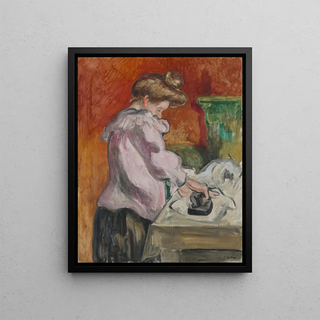Art print | The Ironer - Louis Valtat


View from behind

Frame (optional)
In the vibrant world of art, some works stand out for their ability to capture a moment, an atmosphere, an emotion. "The Ironer" by Louis Valtat is one of those creations that transports us into a daily life filled with tenderness and poetry. This artwork, painted in the early 20th century, depicts an intimate scene where the simplicity of the ironing gesture is elevated by mastery of colors and forms. Valtat, through this piece, invites us to contemplate a mundane activity that, under his brush, becomes a true tableau of life, rich in nuances and meanings.
Style and uniqueness of the work
"The Ironer" is characterized by an impressionist style that stands out for its brightness and lightness. The brushstrokes, both swift and delicate, inject a dynamic energy into the composition, while the colors, carefully chosen, evoke a warm atmosphere. The light, omnipresent, plays a crucial role in this piece, illuminating the focused face of the ironer and the draped clothing that seem to almost vibrate under the sun’s effect. Valtat moves away from realistic details to favor a more sensory approach, where texture and color take precedence over form. This uniqueness makes "The Ironer" a captivating painting, where one can almost feel the rustling of fabrics and the warmth of a sunny day.
The artist and his influence
Louis Valtat, an emblematic figure of the post-impressionist movement, managed to leave his mark on his era through his innovative approach to color and light. Trained alongside masters such as Monet and Renoir, he developed a style that is uniquely his own, blending impressionist influences with a touch of modernity. Valtat explored various themes, ranging from landscapes to scenes of daily life, but he excelled in depicting interiors and moments of domestic life. His work also had a significant impact on his contemporaries, inspiring many artists to focus on expressing emotions through scenes of everyday life. "The Ironer" is a perfect example, illustrating how a

Matte finish

View from behind

Frame (optional)
In the vibrant world of art, some works stand out for their ability to capture a moment, an atmosphere, an emotion. "The Ironer" by Louis Valtat is one of those creations that transports us into a daily life filled with tenderness and poetry. This artwork, painted in the early 20th century, depicts an intimate scene where the simplicity of the ironing gesture is elevated by mastery of colors and forms. Valtat, through this piece, invites us to contemplate a mundane activity that, under his brush, becomes a true tableau of life, rich in nuances and meanings.
Style and uniqueness of the work
"The Ironer" is characterized by an impressionist style that stands out for its brightness and lightness. The brushstrokes, both swift and delicate, inject a dynamic energy into the composition, while the colors, carefully chosen, evoke a warm atmosphere. The light, omnipresent, plays a crucial role in this piece, illuminating the focused face of the ironer and the draped clothing that seem to almost vibrate under the sun’s effect. Valtat moves away from realistic details to favor a more sensory approach, where texture and color take precedence over form. This uniqueness makes "The Ironer" a captivating painting, where one can almost feel the rustling of fabrics and the warmth of a sunny day.
The artist and his influence
Louis Valtat, an emblematic figure of the post-impressionist movement, managed to leave his mark on his era through his innovative approach to color and light. Trained alongside masters such as Monet and Renoir, he developed a style that is uniquely his own, blending impressionist influences with a touch of modernity. Valtat explored various themes, ranging from landscapes to scenes of daily life, but he excelled in depicting interiors and moments of domestic life. His work also had a significant impact on his contemporaries, inspiring many artists to focus on expressing emotions through scenes of everyday life. "The Ironer" is a perfect example, illustrating how a






